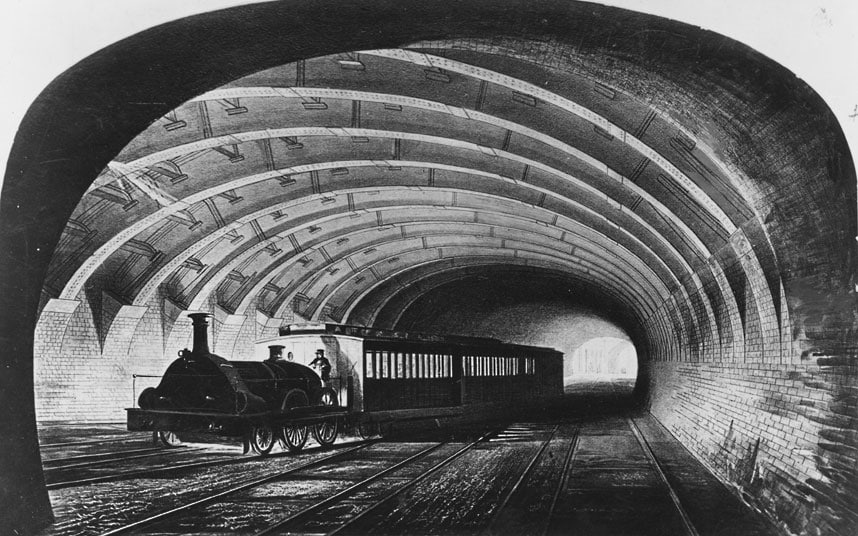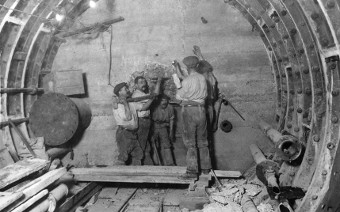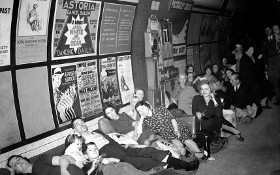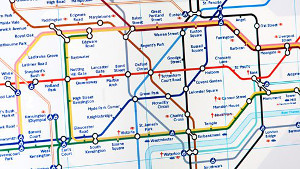|
The London Underground: a Short History
The world's first underground railway was in London. Named the London Metropolitan Underground, it opened on January 10, 1863. The first carriages were wooden, and the first locomotives pulling those gas-lit wooden carriages were powered by steam. The first stretch of underground railway was 3.75 miles long, from Paddington (which was at the time called Bishop's Road) to Farringdon Street. On the first day of operation, 38,000 people got onboard. Passenger totals increased to 9.5 million by the end of one year and 12 million by the end of two years. This was a reflection of the overall population increase of the capital city, which saw large growth in the first half of the 19th Century in the wake of the Industrial Revolution. By the mid-19th Century, railway lines crisscrossed the British Isles and, of course, met in London. Part of the motivation for creating the Underground was a concern with growing congestion on the streets and roads of London and its suburbs. Buses, cabs, and carts filled the travel ways of London proper, and several railroads ended their lines outside the city proper. London city planners wanted to extend the rail network in and around London itself, but the topography didn't lend itself to installation of miles and miles of new rail lines on the already busy city streets. The Solicitor to the City of London in the mid-19th Century, Charles Pearson, helped convince the city government to build a limited underground railway and got permission to proceed. Estimates were that even a limited run would cost 1 million pounds. The Crimean War took needed funding from the underground railway project (not to mention many other building and infrastructure projects); and although the war ended in 1856, it wasn't until 1860 that construction began on what would become the Underground. By 1863, the idea of an underground railway was popular, with several companies angling for a piece of the action. Parliament's upper house, the House of Lords, set up a committee to facilitate the expansion of the underground network. Beginning operation a year later were the Great Western Railway and the London and South Western Railway, extending passenger rail travel potential ever further across the city and its suburbs. Further expansion followed, facilitated by a large handful of other railways, eventually forming today's network. Much of this construction necessitated creating tunnels. A particular challenge was tunneling underneath the Thames River, which runs through the heart of the London area. Engineers Marc and Isambard Brunel (father and son) succeeded in constructing the first sub-Thames tunnel. Called the Thames Tunnel, it opened in 1843. However, the process was so costly that the tunnel opened incomplete and was a pedestrian-only attraction; on its opening day, however, on January 9, 1843, 50,000 curious people walked the length of the tunnel. It took only three months for pedestrian totals to reach 1 million. It remained a passenger tunnel for some time. Steam travel came to the Thames Tunnel in 1869. The Inner Circle, connecting locations in central London, was built from 1863 to 1884. Not longer after it opened, more than 800 trains a day could be found on its tracks. As the 20th Century approached, the Underground was running on electricity. The first electricity-powered railway opened in 1890, and expansions followed. One prime environmental and economic development of the switch from steam power to electrical power was that the tunnels no longer needed vents for the steam-engine-generated smoke to escape; instead, tunnels could go deeper and even be placed on top of one another. It wasn't just the trains that were electrical. Escalators were first used at Earl's Court Station in 1911. It was just after the turn of the century as well that train operators first were able to avoid delays due to the trains' having to turn around at the end of a line. In 1903, the Central London line began using multiple units. Two years later, all Underground lines had followed suit. In this same decade, people began to refer to the Underground as the Tube. The Central London Railway began at that time to be referred to as the "Twopenny Tube." The first use of the name Underground appeared at stations in 1908, the same year that the red circle logo and the first free rail network map appeared. During World War I and World War II, the Underground functioned mainly as shelter from the continual aerial attacks by German planes. Britons commonly used station platforms as air raid shelters. The Government closed some Underground branches in order to use them as storage for items from the British Museum. Network maps were first produced late in the 19th Century and first given away to passengers in 1908. The Tube Map now recognized by hundreds of millions of passengers each year first saw the light of day in 1933, the creation of an engineer and entrepreneur named Harry Beck. He said that he got the idea for the design from viewing a drawing of the electrical circuit of the network. The printed map was a runaway hit with passengers and continues to be popular. The Tube system now in total covers 249 miles, linking 270 stations and 11 railway lines. Station distances run from 300 meters (984 feet) apart to 6.3 kilometers (4 miles) apart.
|
Social Studies for Kids |
Social Studies for Kids
copyright 2002–2025
David White









